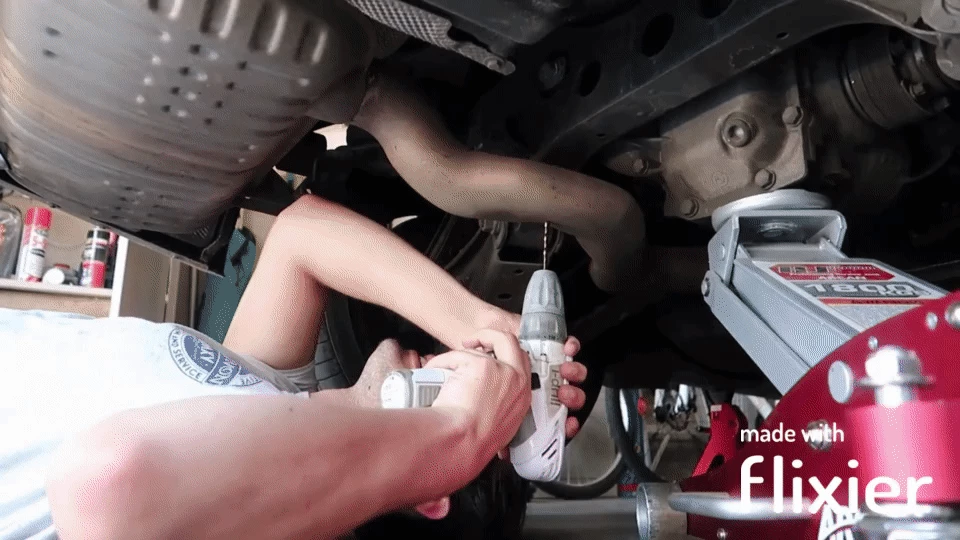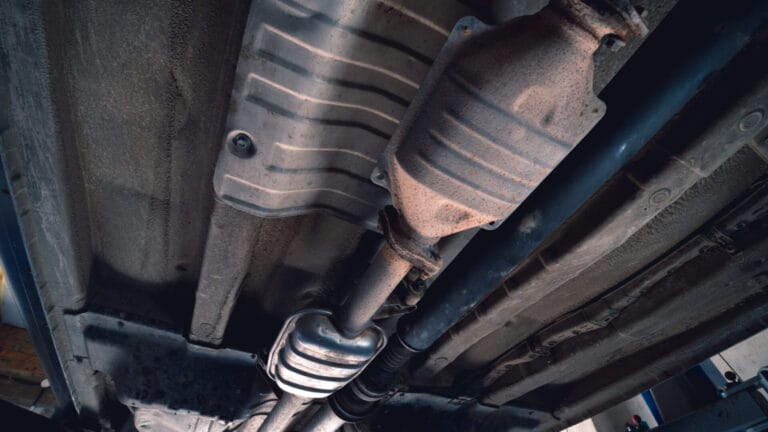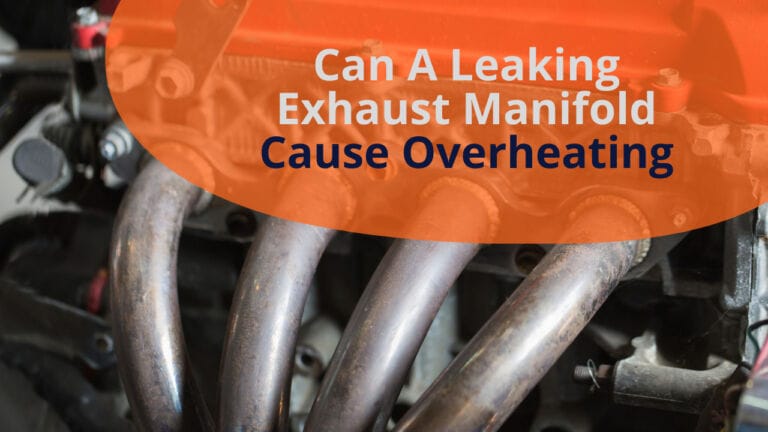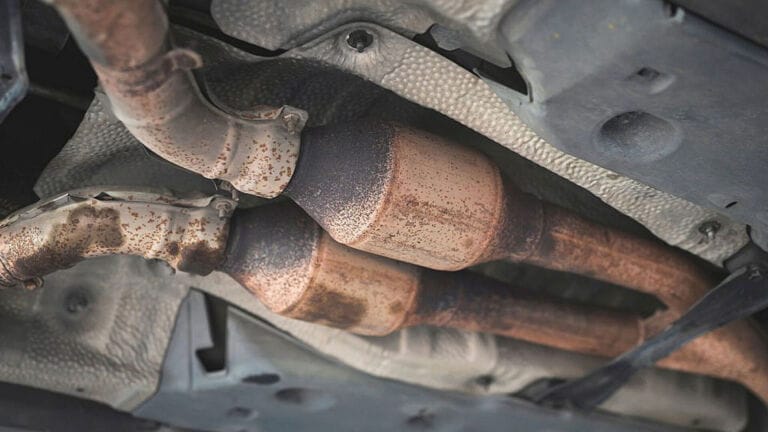Can You Drill Holes in Your Catalytic Converter?
Are you a dedicated car enthusiast always chasing that extra boost in performance?
Have you heard the new whisper, “Drilling holes in the catalytic converter can unlock a hidden powerhouse in car engines and unleash untapped potential?”
Hold on for a moment if you’re revving up to give it a shot. There’s more to this story than meets the eye.
It’s time to find out what lies beneath the hood.
While technically, Cou can drill holes in your catalytic converter, this is one instance where just because you can doesn’t mean you should. Drilling holes can decrease efficiency, cause engine damage, and increase emissions.

Want to dive deeper into this turbocharged adventure before you grab that drill bit to attack headfirst?
Then sit back and be with me till the end. In this blog, I will share why someone might want to drill holes in their catalytic converter, the legality of doing so, and discuss the potential consequences of tampering with your catalytic converter.
Understanding the Role of Catalytic Converters
Your catalytic converter is like a superhero for the environment, albeit a humble one. This small metallic device sits silently under your car, working tirelessly to minimize the harmful pollutants spewing from your vehicle’s exhaust and promote cleaner and healthier air.
A honeycomb structure facilitates a chemical reaction in the combustion chamber that transforms carbon monoxide into carbon dioxide and nitrogen oxides into less harmful substances.
So, each time you drive your car, it’s the catalytic converter that helps keep our air clean and our communities healthy, ensuring vehicles meet emissions testing standards.
Can I Drill Holes in My Catalytic Converter?
While drilling holes in your catalytic converter may seem tempting for various reasons, it isn’t a shortcut to paradise. It will negatively affect your car’s performance, cause a loss of power, poor acceleration, trigger warning lights, release unsafe gases like carbon dioxide, and affect the overall driving experience.
So, it is not a good idea to alter the catalytic converter. If you have concerns about your catalytic converter or its performance, you can check out the safe alternatives to boost your car’s performance.
It is always best to consult with a professional mechanic who can provide appropriate solutions and ensure compliance with local regulations.
The Environmental Impact of Drilling Holes in Your Catalytic Converter
Drilling holes in catalytic converters can have severe environmental consequences. By modifying the converter, its function of reducing harmful emissions is bypassed, leading to increased air pollution.
When catalytic converters are drilled, they release more exhaust pressure into the atmosphere, contributing to higher levels of greenhouse gases. This goes against efforts to reduce air pollution and mitigate the effects of climate change.
It’s essential to consider the long-term impact of altering catalytic converters and explore better ways to improve exhaust flow and vehicle performance without compromising the environment.
Reasons for Drilling Holes in a Catalytic Converter
Drilling holes in catalytic converters is a practice some people adopt to enhance the performance of their vehicles, and there are actually a few reasons you may choose to do it, too.
Here are the reasons-
- Increased exhaust gas flow leads to Better engine efficiency and better fuel economy.
- Improve engine performance, allowing the engine to breathe more freely
- Louder and more aggressive sound for a sportier driving experience.
- Exhaust gases can pass more efficiently, reducing back pressure.
- Extend converter life and prevent overheating.
Potential Risks of Drilling Holes in Catalytic Converter
Drilling holes in your catalytic converter may appear tempting for performance gains, but it also comes with several potential risks. It harms the environment, can have legal repercussions, and risks your vehicle’s performance, engine health, and resale value.

Let’s recognize the risks of this modification so you can make an informed decision and, hopefully, steer clear of drilling holes in your catalytic converter.
- It decreases the effectiveness of the converter, compromising its ability to convert harmful gases into safer ones like carbon dioxide. This can lead to increased air pollution levels.
- It can trigger the check engine light, indicating a malfunction in the emission control system.
- Increased emissions can lead to respiratory issues and allergies, while environmental damage affects plants and wildlife, posing a significant concern.
- Altering exhaust flow backfires and results in a loss of power, reduced fuel efficiency, raises overheating risks, and can be costly to repair, outweighing any benefits.
- Drilling holes violates emissions regulations, leading to fines, penalties, and potential vehicle impoundment, with overwhelming legal consequences.
- Drilling can lower your vehicle’s resale value, making it less appealing to buyers. Buyers might be concerned about performance, emissions, and legal issues, leading to longer sales.
Is it Illegal to Drill Holes in Your Catalytic Converter?
Drilling holes in your catalytic converter is actually illegal in most places.
You could face heavy fines or legal consequences if you try to remove or interfere with the catalytic converter. Because it reduces vehicle emissions, protects the environment, and improves air quality.
If you want to enhance your vehicle’s performance, consider exploring other legal ways to improve your vehicle’s performance. For example, regular maintenance or upgrading specific components instead of modifying your catalytic converter
Remember, driving responsibly and respecting environmental regulations is the law and the right thing to do for our planet.
How to Drill Holes in Catalytic Converter
Though drilling is not recommended in the catalytic converter, I am sharing a short drilling procedure to punch holes in your catalytic converter:
- Start lifting your vehicle using the appropriate equipment, like a lift farm jack.
- Ensure the catalytic converter underneath is easy to access.
- Carefully disconnect and remove the catalytic converter, and check for damage or malfunction.
- Then, take an appropriate bit-size drill machine and carefully drill holes into the catalytic converter.
- Once drilling is done, reinstall the catalytic converter securely, ensuring proper connection and alignment.
Can I Hollow Out a Catalytic Converter?
Hollowing out a catalytic converter is another modification car enthusiast do to increase their vehicle performance. It involves gutting the internal catalyst (the catalyst is what makes the converter “catalytic”), which reduces harmful emissions from your vehicle’s exhaust.
As a result, you enjoy enhanced engine performance. But when you remove this stainless steel catalyst, you violate illegal emissions regulations. This can lead to exhaust leak, harming the environment and human health.
Additionally, it lacks the heat shield against extreme temperatures, potentially damaging your engine. So, hollowing out a catalytic converter is an unwise choice.
How to Clean a Clogged Catalytic Converter Without Drilling Holes
Some car enthusiasts think drilling holes in the catalytic converter can remove the clogging. Well, As we already know, drain holes are not the right solution, whatever the problem is!
If the problem is a clogged converter, the simple solution is cleaning. You can clean it with homemade cleaner or buy chemical-based cleaner (specifically designed to break down carbon deposits).
Catalytic cleaning additive is readily available online or near auto arts shops. Just go and buy one, it won’t cost you a fortune (15$-20$).
Let’s learn two simple cleaning methods you can follow if you have a clogged catalytic converter.
Catalytic Converter Cleaning Method Without Removing
If the clog is minor, you don’t have to remove it; you can clean it without it. You must ensure the fuel tank has less fuel (4 gallons or 15 liters). Then follow the below steps.
- Unscrew the bolt and remove the cap of your gas tank. Put a nozzle into the tank to avoid spills.
- Now pour the cleaning solution into the gas tank and screw back the gas tank cap.
- It’s time to drive the car; when you drive the car, the cleaning solution will run through the engine and catalytic converter and clean the clogs it has inside.
- Drive for at least 15 minutes or until the fuel tank is empty.
- Reach to a nearby fuel station and fill the fuel tank as usual. Your car catalytic converter is now free of minor cloggings and ready to drive again.
You can follow this process after you drive 8,000km to keep the converter free of any build-up and in good condition.
Catalytic Converter Cleaning Method By Removing
Cleaning catalytic converters by removing them is also simple and more effective. You can use homemade or store-bought (pb blaster), any cleaning solution, or whatever you have available.
- Let’s make a homemade cleaning solution by mixing laundry detergent and water in a large bowl or bucket and keeping it aside. You can add a few drops of ammonia for better results. Or take the store-bought cleaning solution.
- Now remove the catalytic converter from your vehicle and soak it in the cleaning solution overnight.
- Or if you want to use store-bought cleaner, you can’t soak the catalytic converter as it will cost you a lot. So you can plugged cat with a pressure washer or garden hose with a nozzle.
- Spray inside the catalytic converter through both ends on the lowest setting.
- Continue spraying until all the buildup is broken and comes out or you are satisfied.
- Once cleaning is done, use a clean microfiber cloth or rag and dry the catalytic converter. Or, if you have enough time, let it air dry to avoid any rust.
Safe Alternatives Of Drilling a Hole in a Catalytic Converter
When various safe and legal alternatives are available to enhance your vehicle’s performance, why cross the line into the illegal and environmentally harmful territory?
In fact, these alternatives can boost your vehicle performance more than drilling a small hole can. Let’s explore these options in more detail.
Upgrade To High-Flow Catalytic Converter: Unlocking More Power
A high-flow catalytic converter is your safe, legal, and eco-friendly solution. It amps up engine performance, cuts emissions, and lets exhaust gases flow freely, reducing back pressure.
The result? More power and better fuel efficiency.
You’ll also enjoy a torque boost, perfect for quick starts and towing.
Plus, it’s eco-friendly, helping your engine run cleaner and fostering a greener environment and healthier air.
Cold Air Intake: Unleash the Power of Cold, Dense Air
A cold air intake system is your engine’s best friend. It replaces the old air filter and airbox with a wider, smoother tube and a high-flow filter. This lets your engine breathe cool, dense air from outside, producing more horsepower for thrill-seeking enthusiasts.
But that’s not all. It makes your engine more responsive, improving fuel efficiency. And it adds a fierce exhaust tip and sporty growl to your ride.
Enhance Your Vehicle: Performance Exhaust System
A performance exhaust system boosts your engine’s power and delivers a captivating engine sound. It’s like a high-five for your ride while staying eco-compliant.
The key to a performance exhaust system is high-flow components. For example, a high-flow stock muffler uses a larger and smoother exhaust pipe and a less restrictive design to reduce backpressure and allow exhaust gasses to exit more efficiently. As a result, the engine has to work less to push the stock exhaust out.
This means more power for your drive, especially at higher RPMs. You will also enjoy increased horsepower and torque for immediate performance gains, a sportier exhaust note, better fuel efficiency, and optimized turbocharged engine flow.
Plus, it can boost your vehicle’s resale value. Prospective buyers love the added performance and better sound. Drive on!
Elevate Your Engine: ECU Remapping
ECU remapping is the answer for more power in modern and older vehicles. A professional tuner adjusts the ECU parameters like fuel injection timing and air-to-fuel ratios, all within emissions standards.
The perks? Smoother power delivery, more efficient operation, enhanced towing capacity, and extended engine life. It’s like a second chance for older engines, reducing wear and tear, restoring lost performance, and making your vehicle run better and last longer.
Ready for a smooth and powerful ride? ECU remapping’s got you covered.
Professional Tuning: Unlocking Power While Staying Compliant
Tuning is another legal way to boost engine power, throttle response, and even fuel efficiency.
Sound familiar? It’s like the benefits of a cold air intake system.
A professional tuner accesses and adjusts various parameters in the ECU, including air-fuel mixture, ignition timing, and turbocharger boost levels. These tweaks fine-tune the engine’s operation to deliver more power while ensuring it passes legal emissions tests.
So, consult a pro tuner for the perfect balance of power and responsibility. Your ride will thank you.
FAQs
Will a hole in catalytic converter cause loss of power?
A hole in your catalytic converter can lead to power loss due to decreased backpressure and inefficient emissions control.
What happens if my catalytic converter has a hole in it?
A hole in your catalytic converter can increase emissions and louder exhaust noise. It can also trigger check engine lights and emissions-related issues.
Will drilling holes in a clogged catalytic converter help?
Drilling holes in a clogged catalytic converter isn’t a recommended solution. It can further damage the converter, reduce power, and lead to legal and environmental issues. It’s best to replace or clean a clogged converter.
Conclusion
As a car enthusiast, you stand at the crossroads of choice. One path promises a power boost by drilling holes in your catalytic converter that cause legal troubles, engine damage, exhaust leaks, and harm the environment with toxic gases.
On the other path, consider upgrading to a high-flow catalytic converter or any other safe alternatives that offer performance boosts, staying on the right side of the law and protecting your vehicle.
I have already put the brakes on the myths and steered you in the right direction. Now, you can make the most appropriate decisions for your car, the environment, and driving pleasure.
So, which road will you take?




